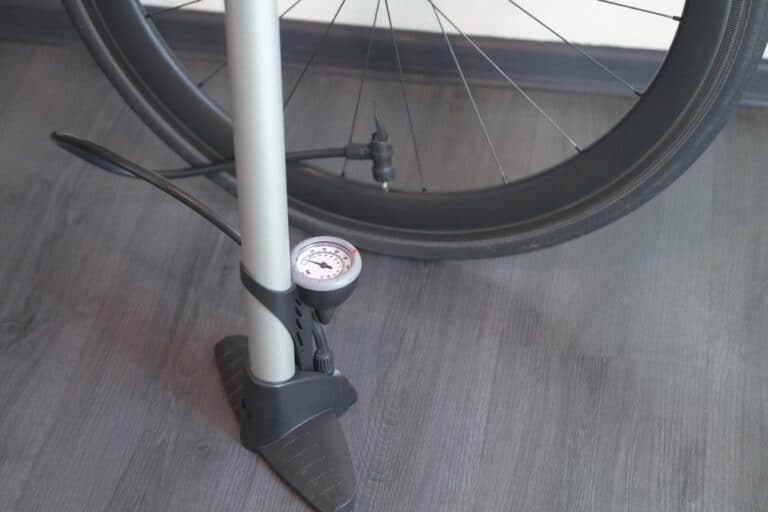Convert Mountain Bike To Road Bike

Mountain bikes and road bikes have prominent differences. So, when the opportunity comes to buy a mountain bike, but you live in the city, you may wonder if you can convert a mountain bike to a road bike.
Converting a mountain bike into a road bike is a long process and can cost a lot of money, but it is possible. To convert the bike, you must replace a few components, including the handlebar, fork, brakes and brake levers, and the tires with their tubes.
When converting your mountain bike to a road bike, you need to consider factors influencing the bike’s steering and mobility. Here are the various aspects to consider if you decide to convert your mountain bike to a road bike.
Can You Convert A Mountain Bike To A Road Bike?
Converting your mountain bike to a road bike can cost a lot of money and take some time. Major components must be replaced when converting your mountain bike, including the handlebars, brakes, and fork.
There are other minor but very prominent pieces of equipment you will need to buy for efficient conversion. The following equipment will be required for a successful conversion:
- A stem that fits the road bike handlebars.
- Headset spacers.
- Road bike handlebars.
- If the handlebars don’t include grip wrap, grip wrap will be needed.
- A road bike fork.
- A headset cap.
- Brake levers that fit the handlebars.
- Downsized v-brakes.
- Brake cables.
- Road bike tires and tubes.
These ten components may set you back a few hundred dollars if you are on a budget, allowing you to buy only entry-level equipment. If you want to modify the bike for full-time or long-distance road biking, the cost can be almost that of a new entry-level road bike.
Once you have bought these ten components, the transformation can begin. Let’s look at the steps to take for a perfect conversion.
The Process For Removing Mountain Bike Handlebars
The handlebars of a road bike are called drop bars. These handlebars achieve the most versatility and flexibility for the riders. Step by step, this is how you remove your current handlebars:
- Using a flat head screwdriver, wedge it between the handlebar and the grip. Spray lube between the handlebar and grip. This will allow you to slide off the grips. Do this for both grips.
- Unscrew the brake levers and remove them from the handlebars.
- Unscrew the gear shifters and remove them from the handlebars.
- Unscrew the stem from the handlebars and remove it and the handlebars.
The Proper Way To Remove Mountain Bike V-Brakes
It is important to note that the v-brakes used on road and mountain bikes differ. The v-brakes on mountain bikes are larger than on on-road bikes. The v-brakes include the mechanism and brake pads on a bike. Removing the v-brakes is the easiest part of the whole conversion. Here is how to remove them:
- Remove the wheels.
- Using the correct tool, for example, a hex key, loosen the brakes all the way.
- Remove the brake mechanism and pads after it is entirely loosened.
- Do this for all four brakes.
The Correct Way To Remove A Mountain Bike Fork
The fork of a bike is a significant part of a bike as it is the part of the bike that keeps the front wheel steady and on track. Here is how to remove it, step-by-step:
- Using a hex key, loosen the headset cap and remove it.
- After loosening the stem bolts, remove the stem from the star nut assembly.
- Remove the star nut assembly.
- Remove the fork from the bike frame.
After all these components are removed, it is time to start putting everything back together by replacing the mountain bike parts with their corresponding rad bike parts.
The Best Way To Install A Road Bike Fork
As placing the new fork takes the longest, it is also seen as the most challenging part of the conversion. This is where the new fork, stem, headset cap, and headset spacers will be used.
- Cut the steer of the fork to the correct length.
- Add the bottom bearing on the steer above the fork.
- Slide the fork and steer into place.
- Add a headset spacer on top after the steer is inserted.
- Add the stem above the spacer.
- Tighten the stem with a hex key.
- Place the next headset spacer on top of the stem.
- Add the headset cap and star nut and tighten with a hex key.

The Easiest Way To Install Road Bike V-Brakes
Placing the new mini v-brakes is the easiest and quickest part of the conversion process. To do so seamlessly, follow the following steps:
- Grease the installation studs.
- Place the mini v-brakes on the studs.
- Align the v-brakes to the correct position.
- Tighten the v-brakes.
- Do so for the front and back brakes.
- Place new road wheels, with the tube, in between the pairs of v-brakes and tighten them to the frame.
The Best Way To Install Road Bike Handlebars And Mechanisms
Reaching this step means that you are almost finished with the conversion. The last step requires placing the new handlebars, the brake levers, and the gear shifts.
- Place handlebars in between the stem.
- Tighten the stem to secure the handlebars.
- Take the gear shifts and slide them onto the handlebars.
- Tighten the gear shifts in the proper position.
- Do the same for the brake levers.
- Connect the brake lever and gear shift cables to the v-brakes and gears.
After the conversion, take the bike for a test drive to ensure that the bike will ride nicely and that there are no faults. If any changes need to be made, ensure that the steps are followed precisely.
Can You Ride A Mountain Bike On A Normal Road?
If you don’t have a road bike, your only bet would be to ride your mountain bike on the road. Depending on your mountain bike type, you can easily ride on the road. Cross-country bikes are the safest bet, as they are easier to ride on the road than trial bikes.
Additionally, it is essential to note that cross-country and trial mountain bikes have disadvantages, which are significant when riding on the road.
- The tires of mountain bikes are much different from the ones used on their counterparts. Mountain bike tires will cause the rider to use more energy as the tires cause more resistance.
- Riding hills on mountain bikes are more difficult as any mountain bike’s frame is much heavier than the ones used on their road counterparts.
- The suspension and brakes used on mountain bikes also add a lot more weight to the mountain bike, which a road bike does not have. This means that mountain bikes will have a difficult time when trying to climb hills because of the frame and the bigger brakes and suspension.
Conclusion
Mountain bikes can be converted into road bikes, but the process takes longer and is not recommended. It is instead recommended to have separate bikes for mountain and road biking. The conversion will be sufficient if you can’t afford a second bike.







